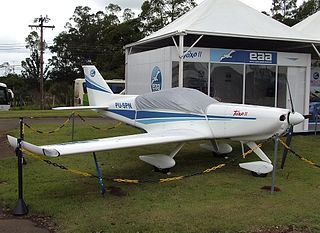Related Research Articles

The Aerosport Quail is an ultralight aircraft that was designed for home building by Harris Woods. First offered for sale in 1971, by the end of the decade, 375 sets of plans had been sold, with around 26 aircraft under construction and 10 flying.

The Hovey Whing Ding is an extremely minimalist American ultralight aircraft that was designed by Bob Hovey of Saugus, California, first flying in 1971. The aircraft is supplied in the form of plans for amateur construction by the Vintage Ultralight and Lightplane Association of Marietta, Georgia.
The Janowski J1 Prząśniczka ("Distaff"), later named the Don Kichot was an ultralight aircraft designed in Poland and marketed for homebuilding in the 1970s. Designed by Jarosław Janowski in 1967 and built with the help of some friends, it flew three years later. It had an unusual design, with a high, strut-braced wing and a pusher propeller mounted behind it. The pilot had a fully enclosed cabin, and the undercarriage was of fixed, tailwheel type. Original prototype was flown with Saturn engine design by Mr Janowski. This engine was made out of two motorcycle engines (MZ250). J1 was also flown with Trabant engine (29HP) and VW conversion (48BPH) made by Christine Aero Engines in Donlands - California.

The Canaero Toucan is a Canadian high-wing, two seats in tandem, twin engine push-pull configuration, twin-boom ultralight kit aircraft that was produced from 1983 to the late 1980s by Canaero Dynamics Aircraft of Rexdale, Ontario.
The Airconcept VoWi-10 is a German two-seat ultralight monoplane designed by Helmut Wilden.

The CFM Shadow is a British Microlight or Group A aircraft designed in the 1980s by David Cook who went on to run ‘Cook Flying Machines’ - where the aircraft was manufactured as a choice of a BMAA fully built machine or an LAA home build kit. It is of high wing, pusher, pod and boom layout and seats two. Around 400 have been built.

The CAG Toxo is a Spanish two-seat ultralight cabin monoplane designed and built by Construcciones Aeronauticas de Galicia for amateur construction.
The Ultralight Engineering Astra is an American high-wing, tricycle landing gear, cable-braced, single-seat, open cockpit, single engine in pusher configuration, ultralight aircraft that was designed and produced by Ultralight Engineering in the 1980s. The aircraft was supplied as a kit for amateur construction.
The International Ultralight Banchee is an American ultralight aircraft designed by Brian Jensen, Gil Kinzie and Nick Nichols and produced by International Ultralight Aviation. The aircraft was supplied as a kit for amateur construction.
The Striplin FLAC is an American flying wing ultralight aircraft that was designed by Ken Striplin in 1977, first flying in October 1978. The aircraft was supplied as a kit for amateur construction.

The TL Ultralight TL-3000 Sirius is a conventional single engine high wing ultralight and Light-sport aircraft seating two side-by-side. It was designed and is produced in the Czech Republic.
The Diehl AeroNautical XTC Hydrolight is an American amphibious flying boat ultralight aircraft that was designed and produced by Diehl AeroNautical in the 1980s. The prototype first flew in March 1982, with production of kits commencing the following year.
The North Wing ATF is an American single-seat ultralight trike designed and produced by North Wing Design of East Wenatchee, Washington. The aircraft is supplied as a kit for amateur construction.
The Procaer Cobra was a two-seat turbojet powered light aircraft designed and built in Italy and flown in the early 1960s. Only one was completed.

The FlyNano Nano is a Finnish electric single seat seaplane, designed by Aki Suokas and produced by FlyNano of Lahti. It was introduced at AERO Friedrichshafen in 2011 and the prototype Proto version first flew on 11 June 2012. When it was available the aircraft was supplied as a complete ready-to-fly-aircraft.
The HB-Flugtechnik HB-208 Amigo is an Austrian ultralight aircraft that was designed by Heino Brditschka and produced by HB-Flugtechnik of Ansfelden. The aircraft is supplied as a kit for amateur construction or as a complete ready-to-fly-aircraft.

The Alpi Pioneer 400 is an Italian four-seat light aircraft, designed produced by Alpi Aviation, of Pordenone. The aircraft is supplied as a kit for amateur construction or as a complete ready-to-fly-aircraft.
The Hubertec Thermik is a German ultralight trike, designed and produced by Hubertec of Aach, Rhineland-Palatinate. The aircraft is supplied as a complete ready-to-fly-aircraft.
The Diamond was a British single seat ultralight aircraft, developed by Arthur Luff in the 1980s. It was notable for its radical design.
The Ultra-Efficient Products Penetrater is an American ultralight aircraft designed by Nick Leighty and Rick Berstling and produced by Ultra-Efficient Products. It was first shown at the 1985 Sun 'n Fun air show.
References
- 1 2 Dunstan, Keith (30 March 1986). "Those Magnificent Men in Their Flying Lawn Mowers". The Canberra Times. Canberra, ACT, Australia. pp. 30–32.
- ↑ Berger, Alain-Yves; Burr, Norman (1985). Ultralight and Microlight Aircraft (2 ed.). Yeovil, Somerset: Haynes Publishing Group. pp. 62–63. ISBN 0-85429-481-3.
- 1 2 3 4 Taylor, John W. R.; Munson, Kenneth, eds. (1987). Jane's all the world's aircraft 1987-88. London: Jane's Yearbooks. pp. 540–541. ISBN 0710608500 . Retrieved 3 June 2023.
- ↑ Parnell, Neville; Boughton, Trevor (1988). Flypast: A Record of Aviation in Australia. Australian Government Pub. Service. p. 345. ISBN 9780644079181 . Retrieved 3 June 2023.
- 1 2 "Ligeti Stratos, 1 km SE Penfield VIC, 22 September 1987". Australian Transport Safety Bureau. 17 June 1988. Retrieved 3 June 2023.
External links
- The Ligeti Stratos, ultralightaircraftaustralia.com (retrieved 5 June 2023)